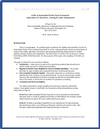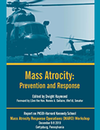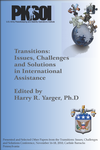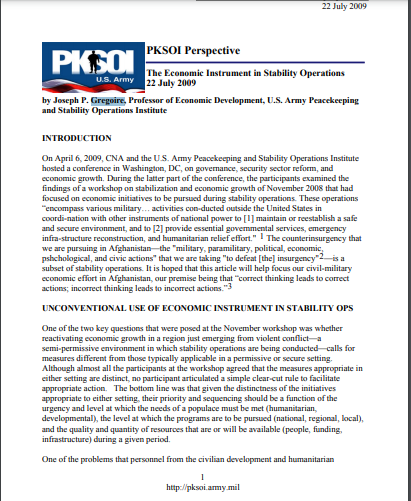Deal with the Devil
How Wagner Created an Alternative to Peacekeeping
Executive Summary
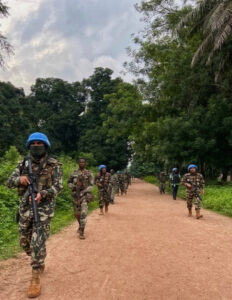
Despite recent events that have called its future into question, to include the 23 August death of its former leader Yevgeny Prigozhin, the Wagner Group, or some successor to it, appears likely to maintain its entrenched position in Africa. Over the past five years, Wagner has rooted itself in several African countries to include those with significant peacekeeping missions. Out of the six active United Nations (UN) peacekeeping missions in Africa, Wagner has a presence in three: Mali, the Central African Republic (CAR), and, until the recent civil war, Sudan. Specifically, in CAR, Wagner has combined offensive clearing tactics, concerted disinformation campaigns, and material support from the Russian state to position itself as a viable alternative to peacekeeping. This has proven to be a winning strategy, especially in the face of rules-based limitations surrounding UN peacekeeping missions, and Wagner has successfully carved out a favorable position within the CAR government with its top operative in the country, Vitali Perfilev, acting as a national security advisor to President Faustin-Archange Touadéra. Though there is little evidence to suggest CAR would follow the Malian junta in demanding the departure of the UN-led Multidimensional Integrated Stabilization Mission in the Central African Republic (MINUSCA), Wagner’s entrenchment in the country still offers key lessons for future peacekeeping efforts, which should consider a host nation’s desire for unscrupulous allies that could threaten human rights as well as the peacekeeping mission itself.
Offensive Clearing Tactics
Wagner’s initial entry into CAR began by filling a security gap that other international partners failed to address. Beginning in 2012, a wave of human rights violations prompted by an ongoing civil war opened the door to multiple peacekeeping missions in CAR. In 2013, the African Union created the International Support Mission in the Central African Republic (MISCA) but transferred its authority over to MINUSCA the following year. Concurrently, France launched its own military mission in support of MINUSCA, Operation Sangaris, which helped provide complimentary, offensive military capability, but ended its mission in 2016. These interventions saw some level of success as they were able to help secure the capital city, Bangui, and support largely peaceful elections in 2016 that resulted in Touadéra’s first term as President. Nevertheless, by early 2017, various armed groups controlled more than an estimated 75-80% of the country, frustrating the CAR government, and civilians who desired “more action against disruptors of the peace.” Non-governmental organizations likewise shared this frustration by claiming, “MINUSCA’s response to attacks is often too little and too late.” These misguided feelings often stemmed from a misconception of MINUSCA’s mandate. As a peacekeeping force, MINUSCA has a defensively oriented mandate that does not explicitly allow for proactive targeting of enemies of the state. Yet, even in defense of civilians, MINUSCA experienced hesitancy in undertaking offensive operations out of fear that doing so would lead down a slippery slope towards potential counter-insurgency operations, which would undermine the very principles of peacekeeping.
To answer this security gap, and reportedly in response to an appeal by President Touadéra to President Putin, Wagner forces entered CAR in March of 2018 with an initial force of 175 “instructors.” Of note, beginning in 2018, the UN reported the presence of some of these Russian personnel among the CAR Presidential Guard. Unlike MINUSCA peacekeeping forces, Wagner mercenaries willingly engaged in offensive action side-by-side with Central African Armed Forces (FACA) troops, often leading from the front despite their role as “instructors.” Utilizing superior firepower, to include air support from helicopters and ground-attack capable planes, Wagner aggressively routed armed groups, answering the previous call from CAR forces for more action. While MINUSCA decision-makers were cautious about counter-insurgency optics, Wagner’s leadership was not; aggressive acts became the norm. Their clearing operations often included indiscriminate attacks on civilians, even at religious sites and internally displaced persons camps. This shift in security tactics represented a completely different approach from peacekeeping goals and objectives. For the Wagner Group, there were no warring sides that needed to be reconciled. Instead, there were enemies that had to be eliminated in support of a client nation and economic concessions to gain.
The government’s shift in tactics violated basic human rights, and they deservedly received condemnation from the international community. Wagner Group inculcated a culture of terror, not just for the local, indigenous armed groups they were facing but also for the civilians they were supposed to protect and for CAR government security forces as well. Yet, the CAR government was clearly not disturbed by this environment or found it worth the security gains. In 2021, after pushing back an offensive by an armed group alliance, the Coalition of Patriots for Change, the CAR government expanded its control to most of the country’s territory and by 2022, their control included all major urban centers. On 30 July 2003, Wagner allies helped secure a referendum election to change the CAR constitution, lifting presidential term limits and providing a path for Touadéra to stay in power indefinitely.
It would be a mistake to attribute all the security gains to the Wagner Group, as MINUSCA adjusted its own strategies to better combat local insecurity, to include deploying additional troops. At its height, Wagner Group likely never numbered more than 2,100 troops in CAR, whereas MINUSCA was able to field 14,400 military personnel and 3,020 police personnel in that same timeframe. It was these sheer numbers that allowed MINUSCA to provide defensive zones in major cities, enabling both FACA and, ironically, Wagner freedom of movement to pursue hot spots. Yet, a narrative developed that Wagner was the sole savior of CAR, a narrative undoubtedly aided by the group’s extensive information campaign.
Information Warfare
Using a network of companies linked to Prigozhin, the Wagner Group has coordinated an extensive information operations campaign that spanned social media, traditional media such as radio, organized demonstrations, and even an action-movie. Its propaganda messaged pro-Russian accolades and either downplayed the existence of Wagner forces or conflated their achievements with well-meaning Russian “instructors.” More importantly, these same tools heaped praise on the Touadéra regime and especially the FACA who, according to these sources, could only achieve its recent success due to Russian assistance. Not only would the information campaign inflate the effects of Russian aid, it would also intertwine these achievements with that of the CAR government, cementing President Touadéra’s own grasp on power while creating a bond between the two entities in the minds of the audience. In this way, Wagner provided more than just a security service but also a propaganda benefit for the Touadéra regime.
The same messaging also created a negative image of other international partners, to include France, the United States, and MINUSCA. Wagner crafted a narrative where it was the hero and other actors were the villains. France especially was an easy scapegoat for Wagner, likely due to a “decades-old track record of military intervention and heavy-handed diplomacy” as well as France’s own history as a former colonial power. Meanwhile, MINUSCA was falsely accused of supplying armed groups, plotting to overthrow the CAR government, and shirking its commitment to protect the CAR people. Not only did these negative campaigns break down trust between the CAR government and MINUSCA, but they also offered an explanation for why peace was so difficult to achieve. If MINUSCA truly was supplying arms to the rebel groups, that would explain the persistence of these groups in fighting, despite years of protracted struggle. Finally, the constant cycle of negative disinformation also muddled the information domain, weakening the effects of negative reporting on Wagner’s own activities as mere fabrications by France and other powers, while also enabling the group to make spurious counter-accusations.
Diplomatic and Material Support from the Russian State
Wagner also enjoyed the backing of the Russian state, and even after the events of late June 2023, Prigozhin continued to enjoy some level of support for his ongoing engagements in Africa until the evening of 23 August. The Russian government leveraged its diplomatic power to ensure Wagner got the equipment it needed in the country despite an arms embargo that had been in place since 2013, exploiting an exception that allowed weapon supplies for FACA. It also continued pushing for amendments that made it easier to ship in heavy weaponry, like mortars and rocket-propelled grenades, by only requiring notification to the UN sanctions committee as opposed to advanced approval. More important than weapons, however, was the military hardware Wagner shipped in with the support of the Russian government, hardware that included ground-attack capable planes, specifically the L-39 Albatross. Though there have not been any confirmed reports of these aircraft in a ground attack role in CAR, there have been reports of Wagner carrying out airstrikes to support their Malian allies, and Mali, like CAR, also received the L-39 Albatross. Additionally, the helicopters Wagner currently flies in CAR act as force multipliers, able to quickly move troops while also providing air support. Both the heavy weaponry and military platforms likely played a key role in Wagner’s success with offensive operations.
Additionally, through its status as a permanent member of the Security Council, the Russian state also retains a strong ability to affect the UN, and by extension MINUSCA. The UN has taken some actions to document and criticize Wagner’s behavior, to include reports by investigative experts. However, as a body, the UN has little punitive authority against Russian companies since Russia has veto power in the Security Council. This can be seen in the Security Council briefings on CAR, where one member state, usually the US or UK, would criticize Wagner’s actions, but the Russian representative would immediately rebut that the Russian presence was lawful and CAR had the sovereign right to choose its security partners. Regardless of the back-and-forth dialogue, Russia’s mere presence on the council ensures no truly punitive measure can pass muster as its veto vote could end MINUSCA’s mandate, much as it did with the UN mission extension in Georgia in 2009.
Conclusion
By presenting a clear alternative to the CAR government, Wagner has become the security partner of choice over MINUSCA. However, cooperation continues between CAR and MINUSCA, and the CAR government is unlikely to follow a path similar to the Malian junta and demand an immediate withdrawal of the UN mission. Currently, the government seems content to enjoy both MINUSCA’s and Wagner’s support. Nevertheless, there is an inherent tension between MINUSCA’s mandate of protecting civilians and Wagner’s own track record, and its actions continue to put MINUSCA personnel at risk. If CAR had to choose partners, the government would likely side with Wagner over MINUSCA. While Wagner enjoys close coordination with FACA, the relationship between MINUSCA and FACA is less sanguine, with consistent violations in the Status of Forces Agreement as FACA patrols obstruct MINUSCA missions.
Prigozhin’s recent passing has cast doubt on Wagner’s future in CAR and the rest of Africa, especially since the incident has raised questions as to the status of Wagner’s relationship with the Russian state. Nevertheless, future peacekeeping efforts should take note of how this private military company carved out a niche in CAR despite MINUSCA’s presence. Unfortunately, the same countries that are most likely to require UN peacekeeping assistance are the ones that could fall for the temptations of malign actors. Countries that suffer from instability, weak institutions, porous borders, and ethnic tensions are likely to backslide into autocratic rule, presenting further challenges for UN peacekeeping.
Additional peacekeeping lessons should include the need for an offensive force to complement the mission without endangering human rights, like the French Operation Sangaris,as well as greater awareness of disinformation campaigns and the tools to counter them. MINUSCA has taken steps with a disinformation working group, but winning over the CAR government at this stage is an uphill battle. MINSUCA and the UN have been largely silent on the conduct of Wagner except for a notable report by the Panel of Experts in 2021. While that report was unflinching in its description of abuses by Russian instructors, since then, follow on reports have been remarkably quiet. In 2022, except for a brief mention of “Russian instructors implicated in abuses,” there is scant discussion of Wagner’s presence. MINUSCA undoubtedly does not want to further antagonize the CAR government, which has been clear about its determination to stick by Wagner. Yet, to remain silent is its own deal with the devil. Even worse, there are indications that Wagner’s influence is spreading, despite its recent setbacks. In Niger, the coup leaders have allegedly reached out to Wagner for support in the face of condemnation by the Economic Community of West African States. More than just an alternative to peacekeeping, Wagner somehow is gaining a reputation as a security partner of choice in western and central Africa, a prospect with dire human rights implications for the entire continent.
About the author: Lt. Cmdr. Thomas Park is a US Navy intelligence officer with 14 years of service. He is currently deployed in the CAR as a MINUSCA peacekeeper.
Disclaimer: The views reflected in this article are those of the author and do not reflect the official position of the Department of Defense, the U.S. Government, the United Nations. The appearance of external hyperlinks does not constitute endorsement by the United States Department of Defense (DoD) of the linked websites, or the information, products, or services contained therein. The DoD does not exercise any editorial security, or other control over the information you may find at these locations.

